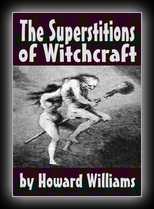
The Superstitions of Witchcraft
by Howard Williams, M.A.
1865
Excerpt:
"In this apology the editors are careful to affirm that they collected, rather than furnished, their materials originally, and give as their venerable authorities the names of Dionysius the Areopagite, Chrysostom, Hilary, Augustin, Gregory I., Remigius, Thomas Aquinas, and others. The writers exult in the consciousness of security, in spite of the attempts of the demons, day and night, to deter them from completing their meritorious labours. Stratagems of every sort are employed in vain. In their judgment the worst species of human wickedness sink into nothing, compared with apostasy from the Church and, by consequence, alliance with hell. A genuine or pretended dread of sorcery, and an affected contempt for the female sex, with an extremely low estimate of its virtues (adopting the language of the Fathers), characterises the opinions of the compilers.
Ennemoser has made an abstract from the 'Demonomagie' of Horst (founded on Hauber's original work), of the 'Hexenhammer,' under its three principal divisions.[105] The third part, which contains the Criminal Code, and consists of thirty-five questions, is the most important section. It is difficult to decide which is the more astonishing, the perfect folly or the perfect iniquity of the Code: it is easier to understand how so many thousands of victims were helplessly sacrificed. The arrest might take place on the simple rumour of a witch being found somewhere, without any previous denunciation. The most abandoned and the most infamous persons may be witnesses: no criminal is too bad. Even a witch or heretic (the worst criminal in the eye of ecclesiastical law) is capable of giving evidence. Husbands and wives may witness one against the other; and the testimony of children was received as good evidence.
The ninth and tenth chapters consider the question 'whether a defence was to be allowed; if an advocate defended his client beyond what was requisite, whether it was not reasonable that he too should be considered guilty; for he is a patron of witches and heretics.... Thirteenth chapter: What the judge has to notice in the torture-chamber. Witches who have given themselves up for years, body and soul, to the devil, are made by him so insensible to pain on the rack, that they rather allow themselves to be torn to pieces than confess. Fourteenth chapter: Upon torture and the mode of[106] racking. In order to bring the accused to voluntary confession, you may promise her her life; which promise, however, may afterwards be withdrawn. If the witch does not confess the first day, the torture to be continued the second and third days. But here the difference between continuing and repeating is important. The torture may not be continued without fresh evidence, but it may be repeated according to judgment. Fifteenth chapter: Continuance of the discovery of a witch by her marks. Amongst other signs, weeping is one. It is a damning thing if the accused, on being brought up, cannot shed tears. The clergy and judges lay their hands on the head of the accused, and adjure her by the hot tears of the Most Glorified Virgin that in case of her innocence, she shed abundant tears in the name of God the Father."
